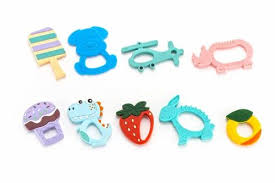Introduction
Teethers and soothers are invaluable tools for comforting babies through the challenging teething phase. They provide relief from gum pain, satisfy natural sucking instincts, and help soothe fussy infants. However, like any baby product, teethers and soothers must be used safely to protect your child from choking hazards, infections, and potential dental issues.
This article offers comprehensive guidance on the safe use of teethers and soothers. We’ll cover how to select appropriate products, safe usage practices, cleaning and maintenance, warning signs to watch for, and expert tips to maximize their benefits while minimizing risks.
Understanding the Importance of Safety
Babies explore the world through their mouths, making them vulnerable to risks if teethers or soothers are improperly designed, used, or maintained. Safety concerns include:
- Choking hazards from small parts or broken pieces.
- Infections due to poor hygiene or sharing.
- Dental problems from improper or prolonged use.
- Strangulation risks from unsafe pacifier cords or attachments.
By adhering to safety guidelines, parents and caregivers can ensure teethers and soothers remain comforting allies in a baby’s development.
Choosing Safe Teethers and Soothers
1. Check for Safety Certifications
Always select products that meet recognized safety standards, such as:
- CPSC (Consumer Product Safety Commission) approval in the U.S.
- EN 1400 certification in Europe for pacifiers.
- Labels indicating BPA-free, phthalate-free, and non-toxic materials.
2. Avoid Small Parts and Loose Attachments
Teethers and soothers should be a single solid piece or securely constructed so that no parts can detach and become choking hazards.
3. Prefer Orthodontic Soothers
For pacifiers, orthodontic shapes are designed to minimize the impact on oral development and are recommended by pediatric dentists.
4. Choose Age-Appropriate Items
Manufacturers design teethers and soothers for specific age groups, considering size, hardness, and developmental stage. Using age-appropriate products reduces risk and improves comfort.
Safe Usage Practices
1. Supervised Use
- Always supervise your baby when using teethers or soothers, especially during the first introduction.
- Avoid leaving babies unattended with items that could break or pose choking hazards.
2. Never Tie Soothers Around the Neck
- Avoid attaching pacifiers or teethers to strings or cords worn around the neck due to strangulation risk.
- Use short clips specifically designed to attach soothers to clothing but never with long cords.
3. Inspect Regularly
- Check teethers and soothers daily for cracks, tears, or signs of wear.
- Discard and replace immediately if damage is found.
4. Limit Pacifier Use
- For dental health, limit pacifier use beyond toddler years (generally 12-24 months).
- Avoid dipping pacifiers in sugary substances.
5. Avoid Freezing Teethers
- While chilling gel-filled teethers in the refrigerator can soothe gums, avoid freezing as extreme cold can damage delicate gum tissues.
Cleaning and Maintenance
1. Daily Cleaning
- Wash teethers and soothers with warm, soapy water after each use.
- Rinse thoroughly to remove all soap residues.
2. Sterilization
- Sterilize pacifiers and teethers regularly by boiling for 5 minutes or using steam sterilizers.
- Check manufacturer instructions for specific recommendations.
3. Avoid Sharing
- Do not share teethers or soothers between children to prevent transmission of germs and infections.
4. Proper Storage
- Store clean teethers and soothers in hygienic containers or sealed bags when not in use.
- Avoid leaving them on dirty surfaces or exposed to pets.
Addressing Common Safety Concerns
Choking and Blockage Hazards
- Use large enough teethers and pacifiers that cannot fit entirely into the mouth.
- Avoid products with detachable decorations, beads, or buttons.
Allergies and Sensitivities
- Watch for allergic reactions to materials like latex; opt for silicone or natural rubber if needed.
- Observe for skin irritation around the mouth caused by drooling combined with pacifier use.
Dental Health Considerations
- Prolonged pacifier use can cause teeth misalignment or bite issues.
- Orthodontic pacifiers help reduce this risk.
- Consult pediatric dentists about when to wean off pacifiers.
Tips for Introducing Teethers and Soothers Safely
1. Timing Matters
- Introduce teethers when your baby begins teething symptoms such as gum swelling or increased drooling.
- For soothers, wait until breastfeeding is well-established (usually 3-4 weeks) to avoid nipple confusion.
2. Observe Baby’s Preferences
- Some babies prefer soft silicone; others may favor firmer wooden teethers.
- Experiment with different shapes and textures.
3. Gradual Weaning
- Start reducing pacifier use by the age of 1 to avoid dependency.
- Replace pacifiers with comfort blankets or toys to ease transition.
When to Seek Help
- If your baby shows signs of allergic reaction: rash, swelling, or difficulty breathing.
- Persistent refusal of teethers or soothers may warrant pediatric consultation.
- If teether or soother use seems to exacerbate dental issues, talk to a pediatric dentist.
Common Myths and Facts
Myth: Soothers Cause Ear Infections
Fact: Some studies suggest pacifier use may slightly increase ear infection risk, but benefits often outweigh risks if used properly.
Myth: Teethers Can Replace Medicine
Fact: Teethers provide comfort but should not replace pediatrician-recommended pain relief for severe teething discomfort.
Conclusion
Teethers and soothers are essential comfort tools in the early stages of a child’s development. Their safe use, proper maintenance, and mindful selection can maximize benefits while protecting babies from potential hazards.
Parents and caregivers play a crucial role in supervising use, maintaining hygiene, and knowing when to limit or discontinue use based on the baby’s needs and developmental milestones.
By following the safety tips and expert advice outlined in this guide, you can confidently support your baby’s comfort and health during teething and beyond.
